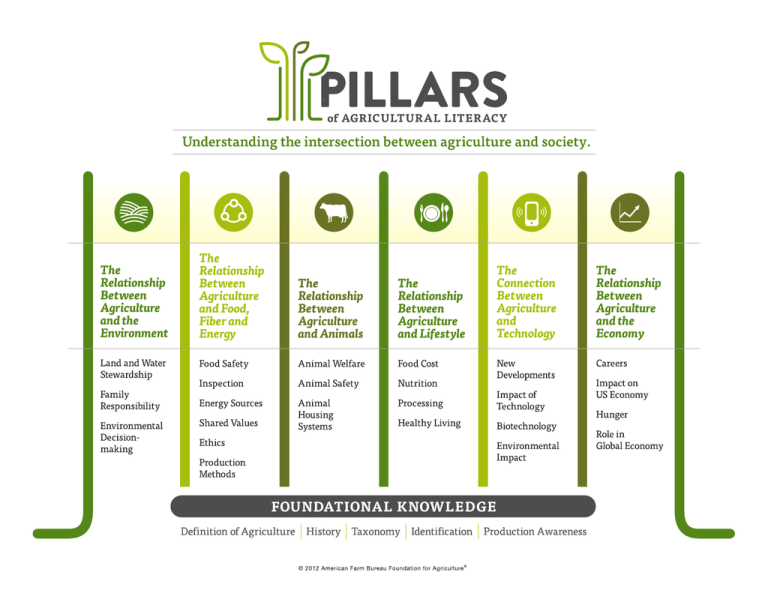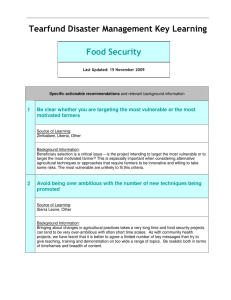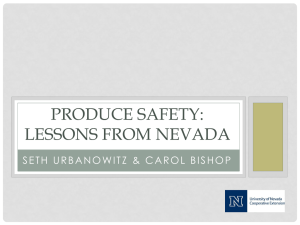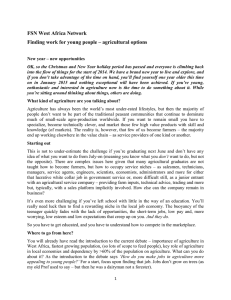Pillars of Ag Literacy - American Farm Bureau Foundation for
advertisement

The Pillars of Agricultural Literacy Overview The following standards offer a framework for agricultural literacy throughout life. Foundational Knowledge is addressed first. This section provides a guide for core knowledge that learners of all age should be able to demonstrate. Following Foundational Knowledge, expectations are divided into four age groups, ranging from early childhood to early adult. As learners progress through age levels, the complexity of what they should know and be able to do with key information increases. This reflects the progressive cognitive development of learners. Informed Consumers and Voters Anaylsis Knowledge - Building Discovery Awareness Intended Users This tool was designed for people planning and managing agricultural literacy programs and initiatives; people who are starting to look at their agricultural literacy efforts from a high level, in order to develop resources that communicate consistent agricultural messages. The tool is also useful for educators implementing formal agriculture learning events in the classroom. It can be used as a basis for alignment to educational standards. This resource offers a way to identify critical issues, pick a target age group and look at key messages to share within this age group. People who have a vested interest in agricultural literacy are encouraged to use this as a starting point when developing resources for fairs, festivals, classrooms, on-farm events or other learning experiences. Note: For the purpose of these standards, the term “farmers” is used to represent farmers, ranchers and all others involved in agricultural production. Foundational Knowledge FDN-1 Definition of Agriculture and Key Vocabulary: Having a grasp of key vocabulary used in agriculture is critical to building awareness and understanding of the industry. Broadly, individuals should know that agriculture is, “all of the industries and processes involved in the production and delivery of food, fiber and fuel that humans need to survive and thrive.” In addition, students should be able to define the following basic terms to deepen and complement their understanding of the definition for agriculture (Other terms may be added depending upon local agricultural priorities.): Terms: Conservation Crops Cultivation Farming Feed Harvest Irrigation Livestock Production Ranching Sustainability FDN-2 Industry Terms: Understanding the taxonomy of the industry is integral to increasing literacy as a whole. Below are examples of specific classifications which should be used a guide based on local production and needs. • Species of livestock (e.g. cattle, hogs, poultry, sheep, etc.). • Terms for species and sexual stage (i.e. cow, heifer, bull, steer). • Plant crops (e.g. horticulture, vegetable, feed, row crop). • Soil FDN-3 Agricultural History: Learners should be able to describe the role of agriculture in global and American history. Examples of key points in agricultural history learners should understand include: • All great civilizations were built upon a strong foundation of agriculture. • Beginning with the cultivation of the fertile land between the Tigris and Euphrates Rivers, the establishment of Mesopotamia is an example of the basic need for agricultural production in any civilization. • Agriculture played an important role in the development of the United States. Colonists brought with them skills for purposeful cultivation of the land. • Significant events involving agriculture have shaped the course of the United States, including the Industrial Revolution, Great Depression, Dust Bowl and the Green Revolution. FDN-4 Identification: Learners will be able to identify local agricultural products and their primary uses. FDN-5 Production Awareness: Learners will be able to describe the general process for the production of an agricultural product. Learners should be aware of the following concepts: • An agricultural product takes a specific path from farm to end user. • Plants and animals have distinct life cycles. • Local, state and federal governing agencies oversee agricultural regulation. • There are a vast amount of systems and companies that support farmers in order to make production operations function. Within these systems, there are many career opportunities. Pillars of Agricultural Literacy - 2 ©2012 American Farm Bureau Foundation for Agriculture® Expectations by Grade Level Early Childhood-3rd Grade (EC): Awareness is the key objective for Early Childhood level standards. At this level, learners are expected to become aware of their connection to farmers. Learners should become aware of general farming practices and basic farm-to-plate processes. 1. The Relationship Between Agriculture and the Environment a. Describe how farmers use land to grow crops. b. List ways that farmers care for the land. c. Describe the importance of water in raising crops and livestock. d. Identify natural resources. 2. The Relationship Between Agriculture and Food, Fiber and Energy a. Identify food safety practices to demonstrate at home. b. Describe the components of a healthy diet using the “My Plate” guide. c. List reasons why farmers would want to grow safe food products. d. Identify the agricultural source for common food, fiber and energy products (e.g. milk from cows, wool from sheep, energy from solar, etc.). e. Discover that farmers plant seeds, care for plants and harvest the product of their work. 3. The Relationship Between Agriculture and Animals a. Identify animals involved in agricultural production. b. Identify uses for animals involved in agricultural production (i.e., work, meat, dairy, eggs). c. Identify ways that farmers care for animals. 4. The Relationship Between Agriculture and Lifestyle a. Recognize that agriculture provides our most basic necessities: food, fiber, energy and shelter. b. Identify healthy food options. 5. The Connection Between Agriculture and Technology a. Describe how technology makes jobs faster and easier in agriculture. b. Describe how technology helps farmers provide more food to more people. 6. The Relationship Between Agriculture and the Economy a. Discover that there are many jobs in agriculture. b. Identify agriculture as an important industry in America. Pillars of Agricultural Literacy - 3 ©2012 American Farm Bureau Foundation for Agriculture® 4th -8th Grade (4-8): Discovery is the key objective for 4th-8th grade standards. At this level, learners are expected to discover how farmers accomplish key tasks, such as sustainability, production and processing. 1. The Relationship Between Agriculture and the Environment a. Discover how natural resources are used and conserved in agriculture. b. Discover how farmers care for the land by using soil conservation practices. c. Discover how farmers care for water sources by preventing water pollution. d. Discover how farmers care for air quality by preventing air pollution. e. Describe why and how farmers conserve water. f. Explain that farmers consider how their actions affect the environment. 2. The Relationship Between Agriculture and Food, Fiber and Energy a. Discover how American farmers keep food safe. b. Explain the role of ethics in the production and management of food, fiber and energy sources. c. Identify common energy sources (i.e., coal, natural gas, oil, wind, solar, hydro). d. Demonstrate safe methods for food handling, preparation and storage. e. Discover how labeling indicates where food and fiber comes from. f. Discover how geography influences the type of agricultural products that can be produced. g. Discover that families own 96-97% of American farms. 3. The Relationship Between Agriculture and Animals a. Give examples of specific ways farmers care for animals. b. Discover how animal-housing systems provide shelter for different species of livestock. c. Explain why farmers consider how their actions affect animals. 4. The Relationship Between Agriculture and Lifestyle a. Discover that there is a cost associated with producing and purchasing food. b. Identify agricultural products that provide valuable nutrients for a balanced diet. c. Discover the path a processed product takes from farm to table. 5. The Connection Between Agriculture and Technology a. Discover specific technology that makes jobs faster and easier in agriculture. b. Discover how technology has changed over time to help farmers provide more food to more people. Pillars of Agricultural Literacy - 4 ©2012 American Farm Bureau Foundation for Agriculture® 6. The Relationship Between Agriculture and the Economy a. Identify jobs of interest in agriculture. b. Identify agriculture as an important industry in America. c. Discover that some foods they eat and other agricultural products they use come from other countries as a result of trade agreements. d. Define the terms “import” and “export”. 9th -12th Grade (9-12): Knowledge-Building is the key objective for 9th-12th grade learners. At this level, learners are expected to build upon key discoveries by adding specific examples of agricultural practices to their bank of knowledge. 1. The Relationship Between Agriculture and the Environment a. Give examples of specific soil conservation practices used by farmers. b. Give examples of specific water conservation and purification practices used by farmers. c. Give examples of specific air pollution reduction practices used by farmers. d. Describe how wildlife habitats are created and maintained by farmers. e. Describe how farmers take environmental impact into consideration when making daily choices. f. Describe how long-term family farms value the environment in order to maintain a sustainable operation over time. 2. The Relationship Between Agriculture and Food, Fiber and Energy a. Identify inspection processes that regulate food safety. b. Connect values held by farmers to values held by learners. c. Explain how energy availability impacts communities. d. Discover how regulatory agencies oversee food, fiber and energy production in America and those commodities imported to America. e. Accurately read labels to determine place of origin for food, fiber and other agricultural products. f. Differentiate between natural, certified organic and conventional farming practices. g. Identify the number of people each American farmer feeds. h. Identify the historical significance of long-lasting family farms. 3. The Relationship Between Agriculture and Animals a. Discover the difference between animal welfare and animal rights. b. Discover specific strategies farmers use to keep animals healthy and safe in livestock production operations. c. Identify reasons livestock safety is a priority for farmers. Pillars of Agricultural Literacy - 5 ©2012 American Farm Bureau Foundation for Agriculture® 4. The Relationship Between Agriculture and Lifestyle a. Accurately read labels on processed food to determine nutrition content. b. Discover why the cost of food in the United States is lower than other countries. c. Describe the value that can be added by processing foods. d. Identify how agricultural products can contribute to a healthy lifestyle. 5. The Connection Between Agriculture and Technology a. Identify how new technology is currently being used in agriculture. b. Define biotechnology as “a collection of technologies applied to agriculture to solve problems and enhance products.” c. Identify the primary benefits and concerns pertaining to biotechnology. d. Discover how improved technology in agriculture can help the environment by requiring less input to produce more. 6. The Relationship Between Agriculture and the Economy a. Explore jobs of interest in agriculture. b. Make a connection between the growing world population and the need for increased agricultural production. c. Identify the U.S. as a major global exporter of agricultural products. d. Identify agriculture as a necessary industry to solve world hunger now and in the future. e. Describe how the relationship of supply and demand impact prices of agricultural commodities. Early Adult (EA): Analysis is the key objective for Early Adult standards. At this level, learners are expected to analyze the impact farmers’ actions make on their everyday life with the intent that they will use this knowledge to inform personal decisions (e.g., voting, food consumption habits, lifestyle, etc.). 1. The Relationship Between Agriculture and the Environment a. Analyze soil conservation practices used by farmers that can be implemented in one’s home. b. Analyze water conservation practices used by farmers that can be implemented in one’s home. c. Analyze air pollution prevention practices used by farmers that can be implemented in one’s home. d. Describe how wildlife habitats are created and maintained by farmers. e. Evaluate how farmers take environmental impact into consideration when making daily choices. f. Analyze how long-term family farms value the environment in order to maintain a sustainable operation over time. Pillars of Agricultural Literacy - 6 ©2012 American Farm Bureau Foundation for Agriculture® 2. The Relationship Between Agriculture and Food, Fiber and Energy a. Evaluate how poor food safety practices in the home negate on-farm food safety practices. b. Analyze the level of food safety requirements held by the United States in comparison to other countries. c. Use knowledge of natural, certified organic and conventional farming practices to make informed decisions when purchasing food and fiber products. d. Analyze how conventional farming practices support population demand. e. Evaluate the cultural and historical value of family farms. 3. The Relationship Between Agriculture and Animals a. Analyze the difference between animal welfare and animal rights. b. Use knowledge of animal rights versus animal welfare to make educated purchasing and voting decisions. c. Evaluate strategies farmers use to keep animals healthy and safe. 4. The Relationship Between Agriculture and Lifestyle a. Make cost-effective food choices. b. Make healthy food choices. c. Use knowledge of basic nutrition to make informed choices. 5. The Connection Between Agriculture and Technology a. Use knowledge of biotechnology to make informed decisions when purchasing agricultural products. b. Consider the primary benefits and concerns pertaining to biotechnology in order to make informed voting decisions. c. Recognize technology in agriculture as a means for solving world hunger challenges. 6. The Relationship Between Agriculture and the Economy a. Use knowledge of U.S. food cost to make informed voting decisions when faced with issues about agriculture. b. Make decisions based on an understanding that the agriculture industry is a vital component of the U.S. economy. c. Analyze how agricultural sustainability impacts a nation’s standard of living. d. Analyze the role American agriculture plays in fighting global hunger. Pillars of Agricultural Literacy - 7 ©2012 American Farm Bureau Foundation for Agriculture® The Pillars of Agricultural Literacy tool is endorsed by the American Farm Bureau Foundation for Agriculture® Board of Directors. The tool is based on relevant research, current industry trends, and stakeholder group priorities. For more information on the development of this tool, please email educationdirector@fb.org. Revised: July, 2013



